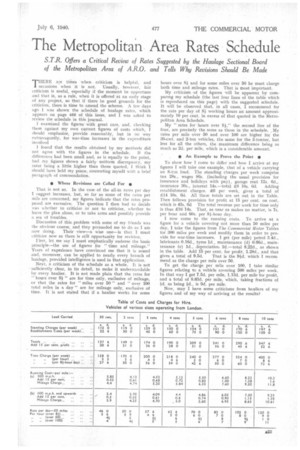The Metropolitan Area Rates Schedule
Page 25

If you've noticed an error in this article please click here to report it so we can fix it.
S.T.R. Offers a Critical Review of Rates Suggested by the Haulage Sectional Board of the Metropolitan Area of A.R.O. and Tells Why Revisions Should Be Made
THERE are tithes when criticism is helpful, and 1 occasions when it is not. Usually, however, fair criticism is useful, especially if the moment be opportune and that is, as a rule, when it is offered at an early stage of any project, so that if there be good grounds for the criticism, there is time to amend the scheme. A few days ago I was shown the schedule of haulage rates, which appears on page 466 of this issue, and I was asked to review the schedule in this journal.
examined the figures with great care, and, checking them against my own current figures of costs which, should emphasize, provide reasonably, but in no way extravagantly, for war-time increases in the expenditure in %,olved
I found that the results obtained by my methods did not agree with the figures in the schedule. If the differences had been small and, as is equally to the point, had my figures shown a fairly uniform discrepancy, my rates being a little higher than those quoted, I think I should have held my peace, contenting myself with a brief paragraph of commendation.
• Where Revisions are Called For •
That is not so. In the case of the all-in rates per day I suggest increases, but, so far as some of the rates per mile are concerned, my figures indicate that the rates proposed are excessive. The question I then had to decide was whether to criticize or not to criticize, whether to leave the plan alone, or to take arms and possibly provide a sea of troubles.
Discussion of this problem with some of my friends was the obvious course, and they persuaded me to do as I am now doing. Their view-a wise one-is that I must criticize now as there is still opportunity for revision.
First, let me say I must emphatically endorse the basic principle--the use of figures for " time and mileage." Years of experience have convinced me that it is sound and, moreover, can be applied to nearly every branch of haulage, provided intelligence is used in that application.
Next, a criticism of the schedule as a whole. It is not sufficiently clear, in its detail, to make it understandable by every haulier. It is not made plain that the rates for " hours over Si " are for time only, exclusive of mileage, or that the rates for " miles over 50 " and " over 100 total miles in a day " are for mileage only, exclusive of time. It is not stated that if a haulier works for some hours over SA and for some miles over 50 he must charge both time and mileage rates. That is most important.
My criticism of the figures will be apparent by comparing my schedule (the last four lines of the table which is reproduced on this page) with the suggested schedule. It will be observed that, in all cases, I recommend for the rate per day of Si working hours an amount approximately 10 per cent, in excess of that quoted in the Metropolitan Area Schedule.
My " rates for hours over Si," the second line of the four, are precisely the same as those in the schedule. My rates per mile over 50 and over 100 are higher for the 30-cwt. and 2-ton vehicles, the same for the 3-tanner, but less for all the others, the maximum difference being as much as 2d. per mile, which is a considerable amount.
. • An Example to Prove the Point •
To show how I come to differ and how I arrive at my figures I will take one example, that of a vehicle carrying an 8-ton load. The standing charges per week comprise tax 28s., wages 86s. (including the usual provision for insurance and holidays with pay), garage rent 123. 6d., insurance :SW., interest 14s.-total £8 10s. 6d. Adding establishment charges. £6 per week, gives a total of £14 10s. 6d. All these totals are set out in the Table. Then follows provision for profit at 15 per cent, on cost, which is 43s. 6d. The total revenue per week for time only is thus £16 14s. That, as near as makes no matter, is 7s. per hour and 60s. per 8i-hour day.
I now come to the running costs. To arrive at a figure for a vehicle covering not more than 50 miles per day, I take the figures from The Commercial Motor Tables for 300 miles per week and modify them in order to provide for war-time increases. I get (per mile) petrol 3.4d., lubricants 0.19d., tyres 1d., maintenance (d) 0.66d., maintenance (e) 1d., depreciation 2d.-total 8.22d., as shown in the table. Add 15 per cent. for profit, 1.28d., and that gives a total of 9.5d. That is the Rid. which I recommend as the charge per mile over 50.
To get the charge per mile over 100, I take similar figures relating to a vehicle covering 500 miles per week. In that way I get 7.5d. per mile, 1.13d. per mile for profit, and a total of 8.63d. per mile, which, taking fractions of id. as being id., is Od. per mile.
Now, may I have some criticisms from hauliers of my figures and of my way of arriving at the results?




















































